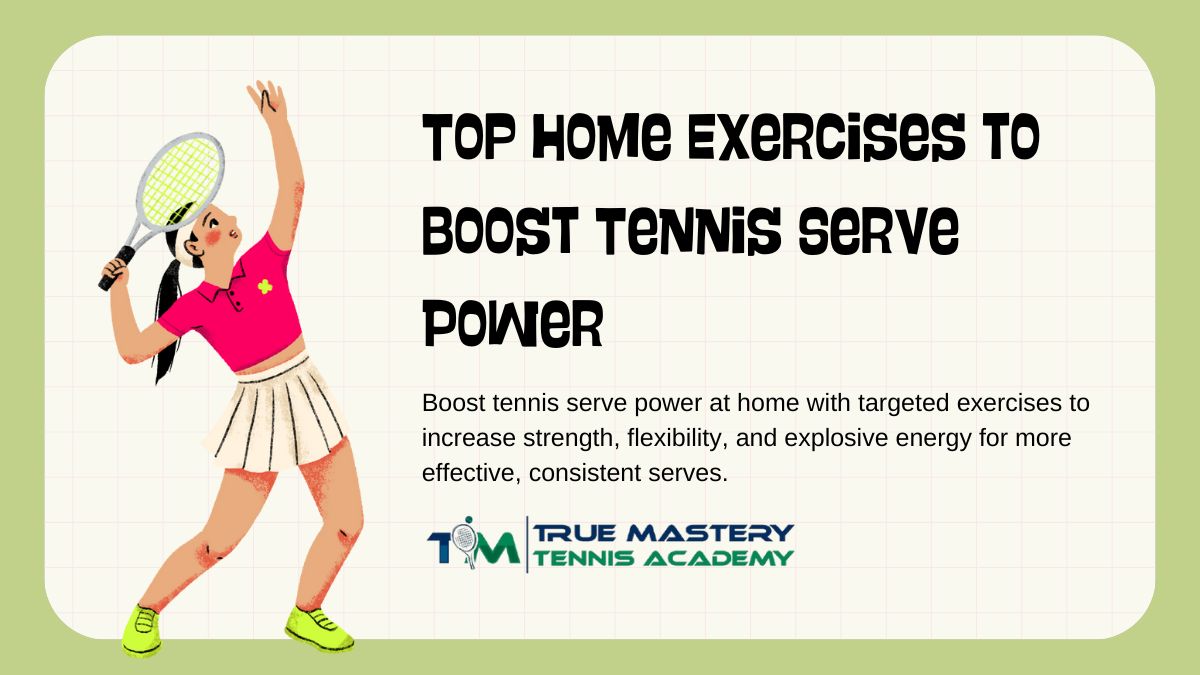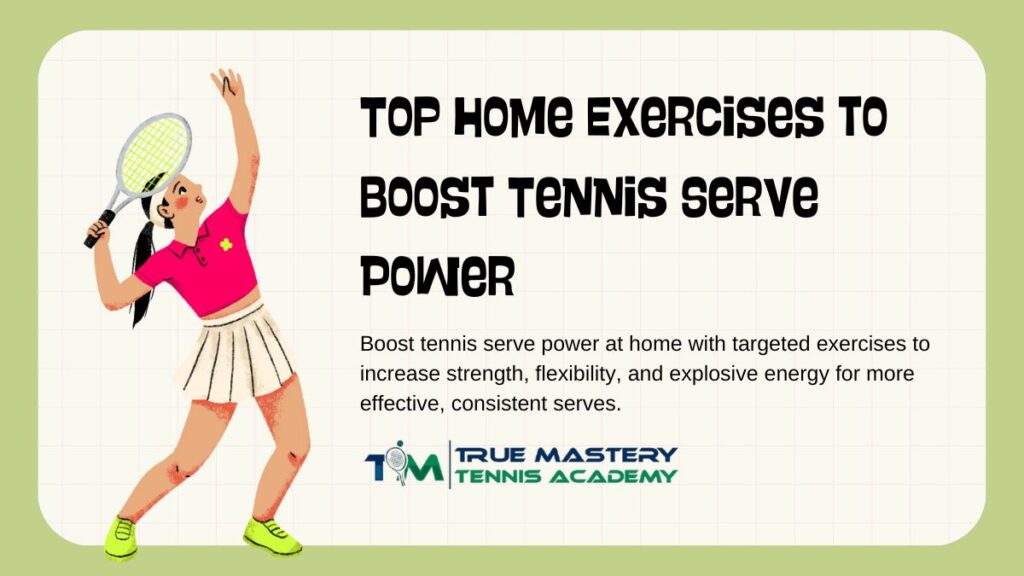Top Home Exercises to Boost Tennis Serve Power
A powerful serve in tennis is the result of strength, coordination, and explosive energy generated from the legs, core, and upper body. Developing serve power doesn’t require a gym membership; with the right at-home exercises, players can enhance their performance while building a strong, injury-resistant body. True Master Tennis Academy emphasizes practical, home-based routines that complement on-court training to help players serve faster, more accurately, and with greater consistency.
Understanding the Mechanics of a Tennis Serve
Before jumping into exercises, it’s important to understand what makes a serve powerful. A successful serve relies on the kinetic chain: energy transfers sequentially from the legs, through the core, into the shoulder, and finally through the racquet into the ball. Weakness or instability at any point along this chain reduces serve velocity and accuracy. Therefore, an effective home program targets lower-body strength, core stability, upper-body power, and explosive coordination.
Leg Strength Exercises for Serve Power
The legs are the foundation of every strong serve, providing stability and explosive drive. Squats are one of the most effective exercises and can be performed with body weight, dumbbells, or resistance bands. Lunges, particularly walking lunges or reverse lunges, develop unilateral leg strength, which is crucial for maintaining balance during a serve. Step-ups on a sturdy platform enhance explosive power and coordination, simulating the upward thrust used during a serve. These leg exercises strengthen muscles in the quads, glutes, hamstrings, and calves, enabling players to generate upward force efficiently.

Core Conditioning for Energy Transfer
A strong core ensures that power generated in the legs is effectively transferred to the upper body. Planks, side planks, and rotational exercises like Russian twists build core stability and rotational strength. Medicine ball throws or slams are excellent for simulating the twisting and uncoiling motion of a serve, reinforcing the connection between torso rotation and racquet acceleration. Regular core conditioning enhances balance, reduces the risk of lower back injuries, and allows players to maintain serve consistency under fatigue.
Shoulder and Arm Exercises for Serve Acceleration
The shoulder and arm deliver the final acceleration to the ball, so strengthening these areas is essential. Resistance band shoulder rotations, dumbbell presses, and lateral raises target stabilizing muscles in the shoulder complex. Bicep curls, tricep extensions, and forearm strengthening exercises improve arm endurance and control. Incorporating eccentric movements—where the muscle lengthens under tension—helps prevent common overuse injuries like tennis elbow. At-home exercises focusing on these muscles prepare players for repeated, high-speed serves during practice and matches.
Plyometric and Explosive Power Drills
Explosive movements mimic the dynamic nature of a tennis serve. Jump squats, lateral hops, and medicine ball chest passes enhance fast-twitch muscle activation, improving reaction time and serve speed. Performing these exercises with proper form ensures that energy flows efficiently from the legs through the core and into the arm, maximizing ball velocity. Plyometric routines also enhance joint stability and reduce injury risk, allowing players to hit powerful serves consistently over extended sessions.
Flexibility and Mobility for Serve Efficiency
A flexible body allows a player to reach full extension during the serve, improving leverage and ball speed. Shoulder mobility exercises, hamstring stretches, hip openers, and thoracic spine rotations enhance range of motion, making each serve more effective. Foam rolling or self-myofascial release can alleviate tightness and improve muscle elasticity, contributing to smoother and faster serves. True Master Tennis Academy emphasizes that flexibility complements strength, allowing players to achieve optimal serve mechanics without strain.
Creating a Balanced At-Home Serve Routine
A weekly home routine can combine leg, core, and upper-body exercises with plyometric and mobility drills. For example, two leg and core sessions per week, two upper-body sessions, and daily mobility work ensures comprehensive conditioning. Gradually increasing intensity and resistance improves muscle endurance and explosive power without overloading joints. By pairing these exercises with regular on-court practice, players can translate at-home conditioning gains into faster, more consistent serves.
Case Study Reference
A study conducted on collegiate tennis players found that athletes who performed a structured home program focusing on core, legs, and shoulder strength improved serve velocity by an average of 7% over eight weeks. Another research analysis highlighted that plyometric training combined with resistance exercises enhanced serve power and reduced shoulder strain in youth tennis players. These findings confirm that consistent, targeted home exercises are a key factor in developing a stronger serve safely.
Integrating Home Exercises with On-Court Practice
While home exercises build strength and power, translating those gains to the court requires thoughtful practice. Shadow serving, wall drills, and racquet acceleration exercises complement conditioning by refining technique. Focusing on serve rhythm, timing, and explosive release during practice allows players to apply the strength and mobility developed at home directly to the serve. True Master Tennis Academy stresses that the combination of conditioning and court practice yields the best performance improvements and reduces injury risk.
Conclusion
Enhancing serve power is achievable without an expensive gym or specialized equipment. A structured at-home routine targeting legs, core, shoulders, and explosive power, combined with mobility and flexibility work, builds the foundation for faster, more consistent serves. True Master Tennis Academy emphasizes integrating these exercises with on-court practice to maximize results while reducing the risk of injury. Players who commit to home conditioning can expect stronger serves, improved endurance, and greater confidence on the court.
For guidance on combining home exercises with on-court drills, explore our tennis programs and lessons to receive tailored plans that match your goals and skill level.
Click on the link to find out more about TM Tennis Academy’s lesson package. Chat with our head coach today!
About TM Tennis Academy
Private Tennis Lessons
Kids Tennis Lesson
Group Tennis Lessons
Whatsapp Us




